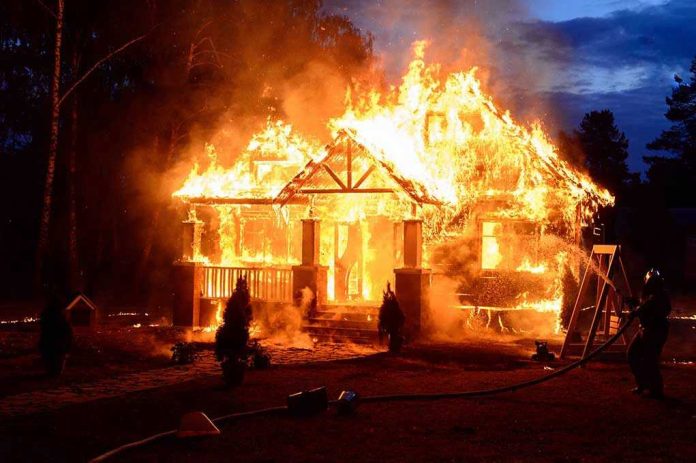
A single flick of a light switch transformed a quiet Southern California neighborhood into a disaster zone, exposing hidden dangers that could be lurking under any suburban street.
Story Snapshot
- A Chino Hills home exploded without warning, injuring eight—including several children—and damaging nearby houses.
- A suspected gas leak is under investigation, with utility crews and bomb squad combing through debris for answers.
- Sixteen families faced evacuation, and the trauma of sudden disaster has rippled throughout the community.
- Past incidents and aging infrastructure raise urgent questions about gas safety in America’s neighborhoods.
Explosion Shatters Suburban Calm in Chino Hills
On the afternoon of November 16, 2025, Sierra Vista Drive in Chino Hills, California, was rocked by an eruption so violent that neighbors thought a bomb had gone off. Eight people, including at least six children, suffered injuries. The blast turned a family home into a charred skeleton and sent debris into adjacent houses, leaving a trail of destruction that forced the evacuation of sixteen homes. The echoes of the explosion replaced the ordinary sounds of children playing and neighbors chatting, upending the sense of safety many take for granted.
Local emergency responders rushed to the scene within minutes, evacuating families and shutting off the gas supply to prevent further catastrophe. Witnesses described chaos: children and adults fleeing the burning wreck, some with visible burns and wounds. As night fell, utility workers and investigators worked under floodlights, hunting for the source of the disaster. The gas leak, suspected as the likely cause, forced an urgent assessment of all nearby lines, a reminder that even state-of-the-art modern neighborhoods are not immune to aging infrastructure and oversight gaps.
Community Displaced, Trauma Lingers After the Blast
The explosion’s aftermath revealed the deep impact such events can have beyond physical destruction. Sixteen homes were evacuated, leaving families scrambling for shelter and answers. Four victims were rushed to hospitals, while four others sought medical care on their own. Two children, critically injured, remained in intensive care with burns and breathing complications, though doctors expected all to survive. Most displaced residents returned home within a day, but for those whose homes were destroyed or severely damaged, the road to recovery stretched far ahead.
The tight-knit Chino Hills community rallied, offering support and sharing their fears. Many residents voiced frustration over a perceived lack of warning, especially after reports surfaced of utility workers and police in the area before the blast. The trauma inflicted by the explosion raised pressing concerns about both the physical and psychological toll of such disasters—especially on children who, until that day, had known only peace on their street.
Investigators Probe the Source: Was This Preventable?
In the days following the explosion, investigators from the Chino Valley Fire District, the San Bernardino County Sheriff’s Department, and the bomb squad scoured the wreckage. The working theory—an undetected gas leak ignited by a child flipping a light switch—drew on familiar patterns seen in prior California gas explosions. Utility crews traced the gas lines, hunting for clues in scorched pipes and singed foundations. The involvement of so many agencies signaled the gravity of the event and the complexity of modern gas infrastructure.
Chino Hills is not alone in its vulnerability. California’s history is marred by gas-related disasters, from the 2010 San Bruno pipeline explosion to lesser-known but still devastating incidents in suburban homes. Experts emphasized that while such explosions are rare, they carry outsized risks in densely populated areas. The Chino Hills blast has reignited debate over the adequacy of gas safety protocols, the need for routine inspections, and the responsibilities of utility companies like SoCalGas.
Aftermath Spurs Calls for Reform and Greater Vigilance
The Chino Hills explosion has already set in motion a series of responses with implications far beyond the cul-de-sac where the tragedy occurred. Insurance claims and possible lawsuits loom as families seek compensation for injuries and lost property. Local officials face mounting pressure to demand more rigorous safety checks from utility providers. The broader Chino Hills community, shaken by the blast, is questioning whether enough is being done to prevent another tragedy.
Industry experts warn that America’s aging gas infrastructure is a ticking time bomb in many neighborhoods. They point to the need for advanced detection systems, better public education on gas safety, and a culture of transparency among utility companies. Meanwhile, survivors in Chino Hills face the immediate tasks of healing and rebuilding. Their ordeal stands as a stark reminder: beneath the surface of any American suburb, unseen dangers can lurk, waiting for a single spark.












